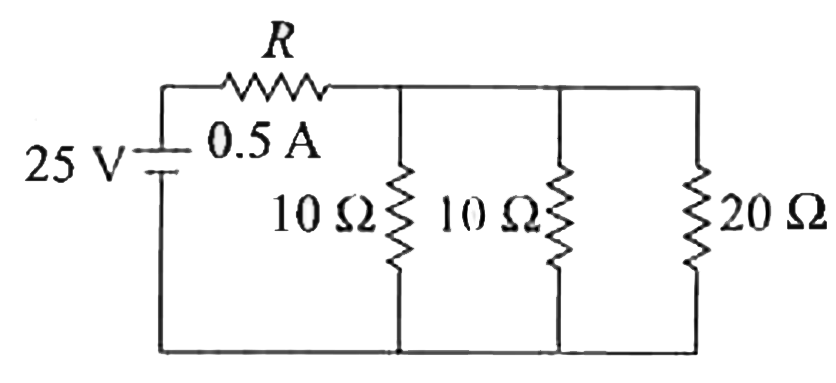In the circuit shown in Fig 7.25,
(a) what must the emfε of the battery be in order for a current of 2.00A to flow through the 5.00V battery , as shown ? In the polarity of the battery correct as shown ?
b. How long does it take for 60.0J of thermal energy to be produced in the 10.0Ωresistor?

The correct Answer is:(a) 108.75V Polarity should be reversed
(b) 13.5s
(a) First , do series // parallel reduction . Now, apply kirchhoff's laws and solve for e.
ΔVadefa=0or−(20Ω)(2A)−5V−(20Ω)I2=0orI2=−2.25A
I1+I2=2AorI1=2A−(−2.25A)=4.25A
Delta V _(adefa) = 0 or ( 15 Omega) ( 4.25 A) + epsilon - ( 20 Omega) ( - 2.25 A) = 0<br> epsilon = - 108.75 V , Polarity should be reversed.
(b) Parallel branch has a 10Ω resistance.
ΔVPar=RI=(10Ω)(2A)=20V
Current in upper part is I=ΔVR=20V30Ω=23A
Pt=UorI2Rt=U
or ((2)/(3) A)^(2) ( 10 Omega )t = 60 J or t = 13.5 s

Topper's Solved these Questions
- HEATING EFFECT OF CURRENTBook:CENGAGE PHYSICSChapter:HEATING EFFECT OF CURRENTExercise:Single Correct
Explore 60 Videos
- HEATING EFFECT OF CURRENTBook:CENGAGE PHYSICSChapter:HEATING EFFECT OF CURRENTExercise:Multiple Correct
Explore 5 Videos
- HEATING EFFECT OF CURRENTBook:CENGAGE PHYSICSChapter:HEATING EFFECT OF CURRENTExercise:Exercise 7.1
Explore 22 Videos
- GRAVITATIONBook:CENGAGE PHYSICSChapter:GRAVITATIONExercise:Question Bank
Explore 39 Videos
- INDUCTANCEBook:CENGAGE PHYSICSChapter:INDUCTANCEExercise:Concept Based
Explore 9 Videos
Similar Questions
Knowledge Check
In the circuit as shown if the current drawn through battery is 0.5A. Then
 AResistance R = 46ΩBCurrent through 20Ω resistance is 0.1ACPotential difference across the middle resistance is 2VDPotential difference across the 20Ω resistance is 4V
AResistance R = 46ΩBCurrent through 20Ω resistance is 0.1ACPotential difference across the middle resistance is 2VDPotential difference across the 20Ω resistance is 4VFor the circuit shown figure answer the following questions

For what value of R, current through 7V battery is zero?A3ΩB4ΩC5ΩD6Ω
In the circuit shown in fig. 7.24 , all the resistors are rated at a maximum power of 1.00W. What is the maximum emfε that the battery can have without burning up any of the resistors?

View SolutionIn the circuit shown in Fig.6.2, the heat produced in 5Ω resistor, due to the current flowing through it is 10 calorie per second. Find the heat produced in 4Ω resistor.
View SolutionIn the circuit shown in Fig.6.2, the heat produced in 5Ω resistor, due to the current flowing through it is 10 calorie per second. Find the heat produced in 4Ω resistor.
View SolutionIn which branch of the circuit shown in figure a 11V battery be inserted so that it dissipates minimum power. What will be the current through the 2Ω resistance for this potential of the battery?

View SolutionIn the circuit shown in Fig. 4.64, the battery has an emf of 12.0 V and an internal resistance of 5R/11. If the ammeter reads 2.0 A, what is the value of R ?

View SolutionConsider the circuit shown in Figure . The terminal voltage of the 24.0 V battery is 21.2V. What are
(a) The internal resistance r of the battery and
(b) The resistance R of the circuit resistor ?

View Solution


